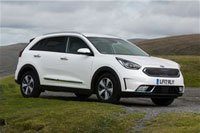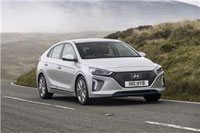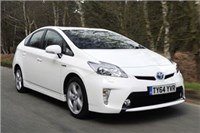Should I buy a PHEV or Hybrid?
Could a PHEV or Hybrid car save you money? We explain the differences between the two and show which will work for you.

What is a PHEV?
Like a 'normal' hybrid car, a plug-in hybrid (or PHEV) combines an electric motor with a petrol or diesel engine. It differs in that it can be charged by being plugged in, like an electric car.
While hybrids rely on their petrol or diesel engine alongside the electric motor, PHEVs can travel further under electric power alone - usually capable of covering 20-40 miles before the engine kicks in. This means you'll save money on fuel and emit fewer tailpipe emissions when the car's been charged.
If you do need to travel further afield, PHEVs can cover long distances without a charge. This means they're ideal if most of your journeys are short (e.g. commuting) but occasionally you need to travel further.
What is a hybrid?
A hybrid car combines a petrol or diesel engine with an electric motor. Although these can sometimes travel under electric power at limited speeds for short distances, the electric motor usually works at the same time as the petrol or diesel engine.
The advantage of this is increased efficiency in terms of fuel economy and CO2 emissions compared to a conventional petrol or diesel car without an electric motor.
Unlike an electric vehicle, you don't need to charge a hybrid car and they're capable of travelling long distances without a break, meaning many car buyers see hybrids as a good middle ground between combustion-engined cars and electric vehicles.
So what are the differences?
Plug-in hybrid vehicles usually have a bigger battery than a conventional or 'self-charging' hybrid. This means it can travel further on electric power alone and, when charged, is more efficient than a traditional hybrid vehicle.
Unlike parallel hybrids, plug-in hybrids require charging to work at their most efficient. If you don't charge a PHEV, it will be relying on the engine to charge the batteries, which uses more fuel. You don't have to charge a plug-in hybrid, though - in fact, many drivers don't bother, choosing just to drive them for their tax advantages.
Top 10 PHEVs
1. Kia Niro PHEV |
2. Mitsubishi Outlander PHEV |
3. Hyundai Ioniq Plug-In |
 |
 |
 |

Why are hybrids more expensive than petrol/diesel?
As is often the case with new technology, hybrid vehicles are more expensive to cover the extra development costs that have gone into making them. The price of batteries and the rare metals that go into them will also drive up the cost.
What's the range of a PHEV?
The electric range of a PHEV is increasing as battery technology develops. The Volkswagen Passat GTE can cover 34 miles before the petrol engine kicks in under WLTP fuel economy tests, while the Mitsubishi Outlander PHEV can travel 28 miles. These might be slightly less in the real world, depending on factors like your driving style and the weather.
Combined with their petrol engines, most PHEVs will be able to cover more than 400 miles before having to stop for refuelling or recharging.
Why choose a hybrid
Hybrids are at their best around town, at low speeds where little energy is required. Indeed, around town they're very pleasant, able to move around in silence at low speeds with instant response from the accelerator.
At motorway speeds, you'll lose some of the benefits of a hybrid car. They're very heavy, meaning they use a lot of energy to maintain a cruise at 60 or 70mph. You also brake less on the motorway, so they can't recuperate energy using regenerative braking. If most of your driving is at motorway speeds, you'll probably find a diesel to be more efficient.
Are hybrids and PHEVs free to drive in London?
As of April 2019, only cars capable of travelling without any tailpipe CO2 emissions are exempt from the London Congestion Charge. That means conventional hybrids are no longer free to travel in London without a charge.
Only vehicles that meet euro 6 standards (petrol and diesel), emit no more than 75g/km of CO2 and have a minimum 20 mile zero emission capable range will qualify for the cleaner vehicle discount. That means many plug-in hybrids are exempt... for the time being.
That's set to change in 2021. From October 2021, only pure-electric zero-emission cars will be exempt, meaning all hybrids and plug-in hybrids will be charged £11.50 for entering the London Congestion Charge zone during the week. That exemption is currently expected to be withdrawn in December 2025.

>> Find more PCP deals on hybrid and plug-in hybrid cars
How much does it cost to charge a PHEV?
The cost of electricity is usually quoted in terms of kilowatt hours, or kWh. At home, your electricity bill will tell you how much you usually pay for each kWh, but it's usually around 12-13p. A Mitsubishi Outlander PHEV has a 13.8kWh battery so, to charge it fully at home, you're likely to pay between £1.66 and £1.79. With an electric range of around 30 miles, that means you'll pay about 6p per mile when travelling under electric power.
Using public chargers, you'll pay different amounts to charge depending on the network. Ecotricity, which offers 300 electric charge points at motorway service stations across the UK, charges 30p per kWh. That means you'll pay £4.14 to fully charge an Outlander PHEV. BP Chargemaster, which provides access to more than 6500 charge points, offers membership for £7.85 a month. It claims that 70 per cent of its chargers are free to use, while others cost from 10.8p per kWh.
How do I charge a PHEV?
Charging a plug-in hybrid can appear complicated at first, but get your head around it and you could save a fortune in fuel - as well as doing your bit for the environment.
To get the best out of your plug-in hybrid, you'll need to charge it at home. Most PHEVs will come with a cable featuring a three-pin plug at one end, meaning it can be charged from any normal socket. This isn't very efficient, taking as much as seven hours to provide as little as 20 miles of range - but it's fine if you're leaving it charging overnight and there's no alternative.
You'd be best having a dedicated home charge unit installed. The Government is currently offering a grant for 75 per cent towards one chargepoint per household/eligible vehicle, up to £500 - provided you're a named driver on an electric or plug-in hybrid vehicle and have off-road parking. This means you can pick up a home charger for less than £300.
Most home charge units offer charging at a rate of 3.6kW or 7kW - with the latter able to charge a plug-in hybrid entirely in around three or four hours.
Things get a little more complicated when you want to charge away from home. Increasingly, many destinations are now offering free charging stations as an incentive to visit their premises. These are usually 7kW chargers, meaning you'll need to be parked up for a few hours for a full charge, but can provide a useful top-up if you're visiting a destination anyway.
You'll often need to use your own charging cable for these chargers and you might need an app and an account with the provider to access them - although the Government is putting pressure on providers to accept payment using contactless bank cards.
Alternatively, rapid chargers are also offered at convenient locations such as motorway service stations, allowing you a quick top up on a long journey. These are best left to drivers of pure electric vehicles, as they're expensive to use and PHEV drivers might find it cheaper (and easier) just to rely on their petrol or diesel engine for longer distances.
Where can I charge my PHEV without paying?
Charging usually costs money, but some destinations (such as hotels or shopping centres) offer free charging in an attempt to encourage you to spend money at their premises. Many Ikea stores offer Ecotricity charge points in their car parks. These cost money to use, but Ikea will refund you £6 off your bill at the checkout.











